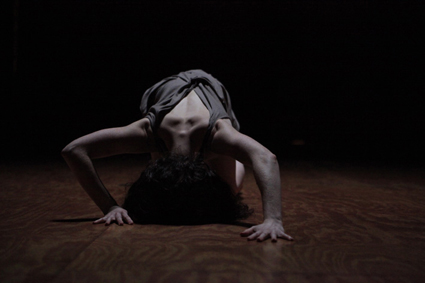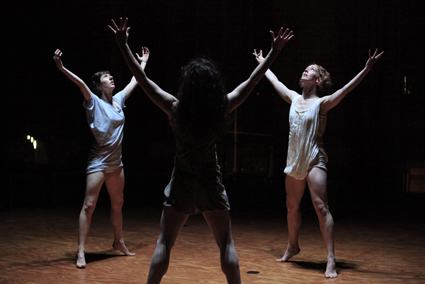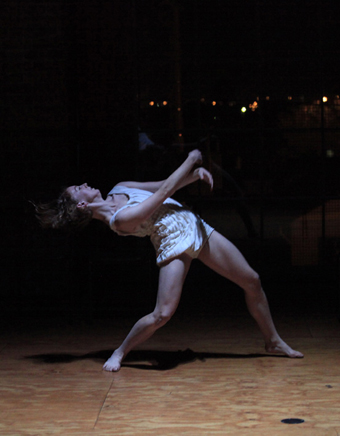Other anatomies, other ecosystems
Jessica Sabatini, Nat Cursio Co, Blizzard

Blizzard, Nat Cursio Co
photo Rachel Bernhaut
Blizzard, Nat Cursio Co
Nat Cursio has written that Blizzard, her latest work for three dancers, presents “animal/human bodies” as “acute listening devices” proposing “a reminder of the delicacy of an ecosystem…a tribute to the ongoing capacity of animal life to…adapt.” At a glance this is a compelling premise for meaningful work and Blizzard does yield some exquisite moments, but as the attempt to translate bodies into devices might suggest, it is not without risk and confusion.
The show opens with confidence and an entrancing sensorial scheme. We are seated in a circle and asked to keep our eyes closed for the initial 10 minutes: a prompt that transforms the vast Newport substation into a nerve-tingling and purely aural field. Sounds are born in the darkness: body-generated, mingling with the whoosh and rumble of nearby trains; sporadic squishing; a rhythmic shuffle of someone—something—prowling about. Alert and somehow prepared by a slightly fearful awe, we open our eyes. The image before us holds something of the sublime.
Head down, the nape of its neck exposed, hair dragging over the floor, a dancer/creature advances in hypnotic slowness into the circle’s centre and out. Its lithe muscles ripple under lunar light; its palms slap the floor; its husky, bronchial purr is in equal parts sleepy, menacing, sensual. What creature is this?
A biped with searching feelers follows, then the intricate undulations of some kind of grub, both with faces averted downward. The enchanted focus of a nature documentary is engendered here. The creatures convince us, with their reconfigured anatomies. At best, we forget we are watching people (then remember); a sensibility beyond the confines of our own species may arise. It’s a beautiful spell, but soon broken.

Blizzard, Nat Cursio Co
photo Rachel Bernhaut
Blizzard, Nat Cursio Co
The three dancers return to the circle—heads lifted, bipedal—and attune to a series of partly synchronised moves: tip-toed, sideways shuffles; pumping elbows; adjustments of footing; full-bodied flourishes with raised legs. There are synchronised gasps too and the timing is impeccable, but the vocabulary is often more mechanistic than organic, laden with nuances that conflict and confuse. Whether these are now insects or mammals is irrelevant, the style itself is unclear: a cerebral medley that evolves very little beyond the rise of an anxious mood.

Blizzard, Nat Cursio Co
photo Rachel Bernhaut
Blizzard, Nat Cursio Co
What really aches in this piece is the dancers’ isolation, the absence of palpable relationships between them and toward us, the circled audience. Ecosystems operate through webs of symbiosis and reciprocity, cause and effect, yet in Blizzard we are presented with, at most, synchronisation, and otherwise with self-absorbed dancers who do not make contact by touch or gaze. Yes, they appear to be threatened, sometimes injured, perhaps endangered, but their neurotic loops of movement resemble the distress of captive animals, not the canny adaptation and outward-directed intelligence of the wild. This may be misguided anthropomorphism: more about the pain of the modern human condition than of creatures of the wild. Whatever the case, the cool distance inspires no affinity.
Just one moment toward the end unites the three dancers, as they gradually find and hold each other’s hands. But it is overdue, too slight and fleeting to mean very much. The great moments, in fact, are played at the start, through bold use of aural and sensory space, and the hushed arrival of that faceless, purring creature as it forges its path.
Blizzard, choreographer Nat Cursio, performers Alice Dixon, Melissa Jones, Caroline Meaden, The Substation, Melbourne, 30 July-4 August
See Philipa Rothfield’s preview of Blizzard in RT’s Online e-dition July 24
This article first appeared as part of RT’s online e-dition 4 Sept, 2013
RealTime issue #117 Oct-Nov 2013 pg. web






